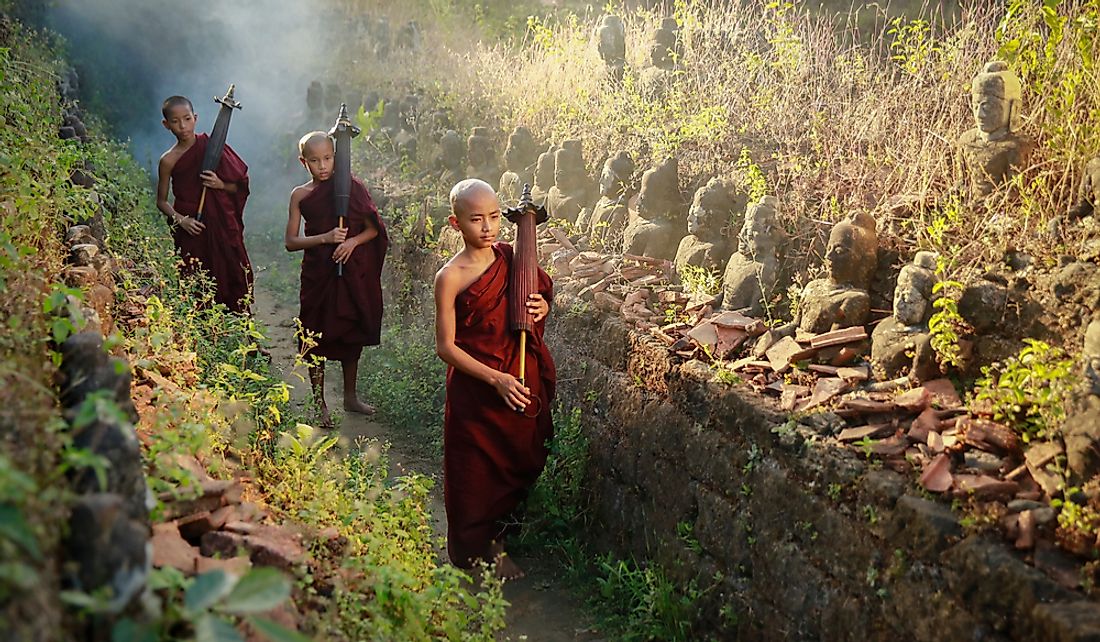The Culture Of Myanmar

The culture of the Southeast Asian country of Myanmar has been heavily influenced by the Buddhist religion, former British colonial rule in the country, and neighboring cultures.
7. Ethnicity, Language, and Religion in Burma
Myanmar, also known as Burma, is home to 55,622,506 individuals. The country is home to diverse ethnic groups. The Burman or Bamar constitute 68% of the total population of the country. The other ethnic communities residing in Burma are Shan, Karen, Rakhine, Chinese, Mon, and Indian peoples. Burmese is the official language of Myanmar. The majority of Burmese (about 88%) practice Buddhism. Christians, Muslims, Animists, and Hindus also live in the country.
Many festivals are held in Burma all year round. The pagoda festival is held in every village and town in the country. Thingyan is another Buddhist festival celebrating the Lunar New Year.
6. Burmese Cuisine
The Burmese cuisine reflects indigenous influences and also has elements of Indian, Thai, and Chinese cuisines. The Burmese dishes are known to have a mild spicy flavor. Rice is the staple of the cuisine and is served with meat curries and vegetables. Soups are also widely consumed. A fermented sauce prepared from preserve fish, Indian-style pickles, shrimp sauce or balachaung, pickled vegetables, etc., are typical condiments of the cuisine. Lentils, tamarind, and chickpeas are also extensively used. Salads are widely consumed. A salad of pickled tea leaves called laphet thoke is very popular in Burma. Mohinga is considered to be the national dish of the country. It is rice noodles in rice-fish soup.
5. Burmese Traditional Clothing
The Burmese men and women both wear a type of sarong-like lower garment called the longyi. In the past, the men would wear the traditional paso and women would adorn the tamein. On formal occasions, Burmese men wear an English collar shirt underneath a Manchu Chinese jacket. Women wear blouses above a sarong. The blouses are either buttoned at the front or on the side. They usually drape a shawl around the blouse. Today, many Burmese men and women also wear Western-style clothing, especially in urban areas.
4. Literature and the Arts in Burma
Burma has a long literary history. Most of the ancient Burmese literature focussed on religion and history. The Jataka Tales of Buddhism were particularly important in shaping early Burmese literature. Various genres of fiction were popularized in the country during British colonial rule. Today, poetry is an important component of the country’s literary works. Novels themed on detective work, romance, and adventure are now produced by Burmese writers. Short stories are also very popular.
Like literature, early Burmese art was also influenced by religion, especially Hinduism and Buddhism, and the mythology and cosmology related to these religions. Impressive Buddha sculptures and pagodas were built in the country in large numbers. Myanmar is also famous for a number of crafts like woodcarving, stone carving, lacquerware, bronze casting, silk weaving, pottery, tapestry making, gold leaf making, etc.
3. Performance Arts in Burma
Myanmar has a rich heritage of music and dance. An array of traditional instruments are used to play Burmese traditional music. This type of music is mostly based on percussion and is extremely melodious. Kyaw Kyaw Naing is a Burmese traditional musician who has helped bring the country’s music to the global platform. The hsaing waing is a type of indigenous orchestra of the nation that involves a musical performance using a combination of various instruments like gongs, drums, hne (reed pipe), wa (clapper and bell), etc. Various dance forms are prevalent in Myanmar like the folk, dramatic, and nat dances. The latter revolves around Burmese religious beliefs. Nats are spirits worshipped by the Burmese. Nat dances are common during the nat pwè festival where the dancers are believed to embody the nat’s spirit in a trance. Historically, these dancers were mainly females and the dancing skill was passed from mothers to daughters. The performances happen in nat shrines spread throughout the country. People visiting the festivals often drink palm wine and dance wildly to the wild beats of traditional drums and gongs.
2. Sports in Myanmar
Football (soccer) is Myanmar’s most popular sport. The country also has its indigenous version of the football called chinlone where a rattan ball is used to play the game. Another local sport is lethwei or Burmese bareknuckle boxing. It is a martial art that originated in the country. Regattas or boat racing events of Myanmar are held annually in the months of August/September. Cricket and basketball are some of the other sports played in Burma.
1. Life in the Burmese Society
Traditionally, women are held in high regard in the Burmese society. Both women and men actively participate in the country’s workforce. The number of activities is divided between the two genders. Many Burmese women own businesses, hold top jobs, and also have important positions in politics. Marriages in the country are mostly based on the choice of the couple and few marriages are arranged. Wedding ceremonies are usually simple for the common people but elaborate for the wealthy sections of society. New-wed couples usually live with one of their parents, usually the bride’s parents after marriage before establishing their own household. Both husband and wife hold considerable authority in the household.
Children are often pampered and adored in Burmese society. Education is valued. In the past, many Burmese boys would attend monasteries to receive religious and other education. Today, the practice has waned significantly.
The Burmese are extremely friendly and outgoing in nature. The public show of emotions like anger and sorrow are not encouraged in the country. The Burmese dislike touching or patting anyone on the head as it is considered improper in Buddhism. People are expected to remove their footwear before entering religious places and homes of the Burmese.











